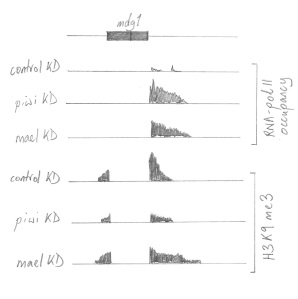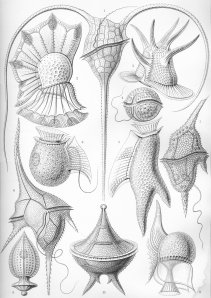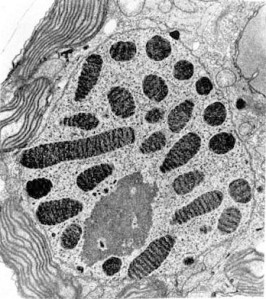A new paper in Nature shows that the social structure of fire ant colonies is determined by a ‘supergene’ – a single non-recombining cluster of hundreds of genes. The supergene makes up more than 50% of a pair of divergent chromosomes. The social chromosomes appear to have emerged in a similar manner by which sex chromosomes evolve.
Colonies of the fire ant Solenopsis invicta can be organised in two different modes, either containing a single queen (monogyne) or multiple queens (polygyne). This social polymorphism has been shown to be associated with a single mendelian genetic factor. Two different alleles, B and b, of the Gp-9 gene, encoding an odorant-binding protein, predict the two colony types. This effect is mediated by worker-ant behaviour. Colonies composed solely of Gp-9BB workers live under a single queen, whereas mixed colonies of Gp-9BB and Bb workers accept many queens. These queens are invariably Bb as the Bb workers will kill any BB queens they encounter. In this way the b allele acts as a ‘green beard’ gene – promoting its’ propagation by behavioural self-recognition. However, it does not spread unchecked through the population as it is recessive lethal – Gp-9bb individuals die early.
The two social forms differ in many aspects of their biology. Monogyne queens tend to found new colonies after long nuptial flights. They build their nests without the aid of workers or foraging and therefore require extensive fat reserves and a longer period of maturation. Polygyne queens often stay within their original nest or undertake limited nuptial flights, hence requiring smaller fat reserves and less maturation. Monogyne colonies are therefore simple families and highly dispersed whilst polygyne colonies contain a number of families, tend to bud from each other and are frequently clustered. These different population structures display different behaviours; the more related monogyne colonies being more aggressive and territorial than those of pologyne fire ants.
Although the Gp-9 encoded odorant-binding protein may well regulate the two forms of social organisation by chemical communication, it was scarcely believable that this panoply of different behavioural, morphological and life-history traits could be regulated by the one protein. Researchers therefore speculated that rather than being the one determining gene, Gp-9 may instead be a marker whose presence correlates with a number of other genetic factors determining the alternative forms of colony organisation.
Clusters of co-segregating genetic loci – ‘supergenes’ – have been found to underlie patterns of adaptive variation regulating different floral types and butterfly mimicry. These types of loci facilitate the co-transmission of many different traits in parallel. They effectively behave like one classically defined gene but are in fact composed of many molecularly defined genes.
Wang et al. have now found that the fire ant colony organisation polymorphism is determined by a supergene. Comparing the haploid sons of BB and Bb queens they discovered a 13Mb region of a 23Mb chromosome in which no recombination occurred between the B and b forms. This region included Gp-9 and at least 615 other genes (6.7% of known S. invicta genes). The vast majority of these genes were present in both chromosome types, but recombination fails to occur due to chromosomal rearrangements. The authors identified one major inversion changing the orientation of 9.3Mb of the non-recombining section.
This heteromorphic pair of ‘social chromosomes’, seemingly regulating many aspects of the monogyny/polygyny division, bears resemblances to sex chromosomes. Recombination continues when B chromosomes are paired (as in XX chromosomes in mammals), whilst it fails to occur between B and b (as in XY). bb, like YY, is non viable. The most widely accepted theory about how recombination is suppressed in the evolution of sex chromosomes from autosomes posits that inversions are selected for when genes with male specific benefits are linked to a male sex-determining gene. It has been hard to prove this theory though, as it is difficult to identify alleles with sex-specific benefits. The demonstration that the same mechanism (ie. inversion preventing recombination and permanently linking alleles) is responsible for the social supergene and chromosomes in fire ants lends support for this model of sex chromosome evolution. One can envisage how a series of inversions gradually permanently links loci responsible for major complex adaptive traits into supergenes and potentially into specialised chromosomes.
Like Y chromosomes, the lack of recombination allows degenerative mutations to build up on the social b chromosome. Wang et al found increased numbers of repetitive elements and longer introns in the non-recombining region. It is because of this accumulation of deleterious mutation that, like Y chromosomes, the b chromosomes contain recessive lethal alleles. Importantly however, during the life-cycle, haploid males containing a single b chromosome have to be viable. This pressure limits the degeneration of the b chromosome in comparison to Y chromosomes.
As yet there is relatively little information on the roles of the 616 genes in the non-recombinant supergene. 70% of genes known to be differentially expressed between BB and Bb workers do however map to the non-recombining region. Further studies will no doubt tackle the molecular mechanisms by which the two social systems differentiate. It will be interesting to ask what proportion of genes in the supergene are directly involved in determination of social system. The authors estimate that suppression of recombination on the social chromosomes started relatively recently in fire ants, 390,000 years ago. Monogyny and polygyny exist in many other species of ant; do similar supergene systems underlie these other instances? Further, how widespread are supergenes? Potentially they could be a common mechanism underlying the evolution of complex adaptations such as social behaviours.
Wang, J., Wurm, Y., Nipitwattanaphon, M., Riba-Grognuz, O., Huang, Y., Shoemaker, D., & Keller, L. (2013). A Y-like social chromosome causes alternative colony organization in fire ants Nature DOI: 10.1038/nature11832
Bourke, A., & Mank, J. (2013). Genetics: A social rearrangement Nature DOI: 10.1038/nature11854






